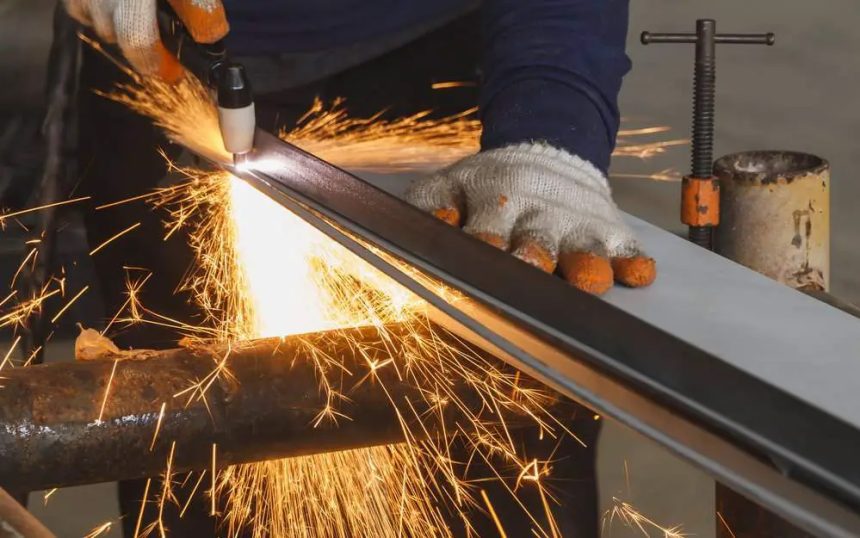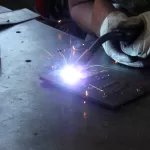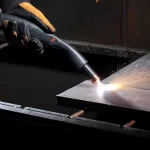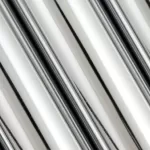When it comes to plasma cutters, two primary types are commonly used: high-frequency plasma cutters and non-high-frequency plasma cutters. Understanding the differences between these two types is essential for a professional welder,. In this article, we will explore the disparities between high-frequency plasma cutters and non-high-frequency plasma cutters.
HF Plasma Cutter vs. Non HF Plasma Cutter
Welding Town
High-Frequency Plasma Cutters
High-frequency plasma cutters are a type of plasma cutting system that uses a high-frequency generator and a relay switch to initiate the arc. The nozzle is positively charged while the electrode is negatively charged. The plasma cutting torch keeps the electrode within the nozzle tip, which is used as an advantage with a high-frequency start. The high-frequency start formula is used at a proportional rate with high voltage. As the plasma gas passes through the electrode and nozzle, it becomes swirling. However, there can be concerns about high-frequency start versions interfering with computer circuitry on CNC tables, although today’s computer equipment is usually shielded from electrical noise. High-frequency plasma cutters are often used for industrial applications where speed and precision are required.
- These cutters initiate the pilot arc by triggering a high-frequency circuit when the user depresses the torch trigger.
- The high-frequency discharge is similar to the energy used to fire a spark plug in a gas engine.
- The operator has to move the torch very close to, or even make contact with the material.
- These systems can have a hard time getting the arc to start when the material surface is dirty, corroded, or painted.
- The resulting electron density in a high-frequency plasma is typically quite a bit higher than a low-frequency plasma.
Non-High-Frequency Plasma Cutters
Non-high-frequency plasma cutters, also known as contact start plasma cutters, use a different method to initiate the arc. Unlike high-frequency plasma cutters, these cutters require direct contact between the electrode and the workpiece. This is often referred to as the contact start formula.
One of the advantages of non-high-frequency plasma cutters is that they are often preferred when used on CNC tables to avoid potential interference with computer circuitry. However, the requirement for direct contact can sometimes be a disadvantage, depending on the specific requirements of the task at hand.
Like high-frequency plasma cutters, non-high-frequency plasma cutters are used in a variety of industrial applications where precision cutting of metal is required. The choice between a high-frequency and a non-high-frequency plasma cutter will depend on a variety of factors, including the specific requirements of the task, the available budget, and the potential for electrical interference.
- These cutters use a mechanical means within the tip of the plasma cutter to start the initial pilot arc.
- The blowback start does not need contact with the metal to start an arc, it is done internally in the torch with the start air pressure moving the electrode away from the nozzle, which creates an arc and starts the plasma flowing.
- Non-High-Frequency plasma cutters are also known as “blowback” start plasma cutters.
- These cutters are able to start a pilot arc without the use of high frequency.
- Many manufacturers are moving away from High-Frequency starting due to the electrical noise interference it can cause with CNC table controllers.
Both types of plasma cutters have their advantages and are chosen based on the specific requirements of the task at hand. It’s always important to match the plasma cutting machine with your budget and your typical metal cutting needs.
How HF plasma cutter machines & pilot arc plasma cutters work
HF plasma cutter machines and pilot arc plasma cutters are used to
cut metals and other materials having electrical conductivity.
Cutting different materials with plasma cutters turn out to be much faster, quite easy
and rather more precise compared to the usage of traditional cutting tools,
like angle grinders for example. As we mentioned at the beginning, the plasma used in this type of cutter machine is a gas, which is highly ionized and is warmed up to a
very high temperature. This gas transfers the power of the arc to the workable material.
Then the great heat induces melting and bloating of the workpiece,
which leads to its cutting via the plasma arc. After the compressed air enters the plasma cutter, the built-in air chamber distributes two separate fluxes – one for the plasma gas, and the other for the subsidiary gas.
Plasma gas arc serves as a melted metal and the subsidiary gas cools the various parts of the cutter and blows the melted metal. Over the years this technology was developed and now on
the market there are two types of plasma cutters – HF plasma cutters and arc
plasma cutters.
What is an HF plasma cutter machine and how it functions
First, let us explain what “HF” in plasma cutter machines means.
It is an abbreviation for “high frequency”, which makes clear that these types of machines use high-frequency circuit to ignite the pilot arc.
Imagine this process similar to a usual everyday activity – something like when you get into your car and turn the key or press a button to start the engine.
Then the spark plugs deliver an electric current from the ignition system to the cylinder of the engine, where the compressed fuel is ignited.
In the case of HF plasma cutter machines, the electrode and the nozzle are in a fixed position.
The HF plasma cutter arc jumps the gap and the air blows the arc out of the nozzle.
The high-intensity spark inside the torch, used to heat the plasma gas in HF plasma cutters, is obtained by high voltage high-frequency AC.
The discharge is transmitted to the torch through wires. Most of the modern industrial plasma machines use the high-frequency method, because it is considered to be the more reliable, especially concerning the high-duty industrial environment.
It can guarantee better, faster, and more precise cutting quality, which is mandatory for business and professional use
Some pilot arc plasma cutting machines that use contact start have a moving electrode inside the torch.
Then the main DC power is activated in the plasma torch, and just a few moments later the gas flow starts in the torch.
This quickly creates a short circuit spark, which ionizes the gas flow through the torch. A significant part of modern plasma cutters on the market today use this technology for hand and mechanized cutting machines
The reason for this wide usage is that this type of equipment is a way too customer-friendly –pilot arc plasma cutters can start the arc without touching the workpiece.
The other main advantage is that the pilot arc can be started on almost any kind of metal surfaces, no matter if they are painted, greasy, rusty, etc. And one of the other big advantages is that it can be used with CNC machines – computer numerical control machines, where the built in computer software can accurately control the position and the velocity of the details.












